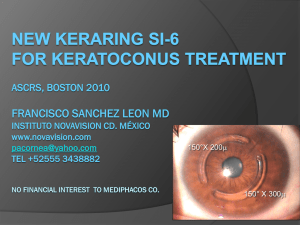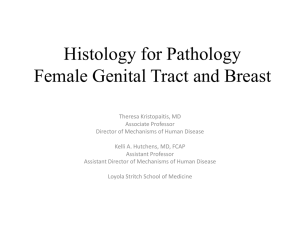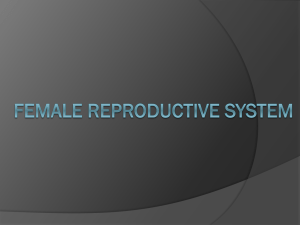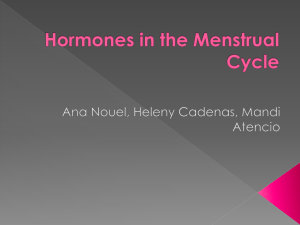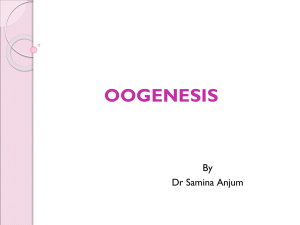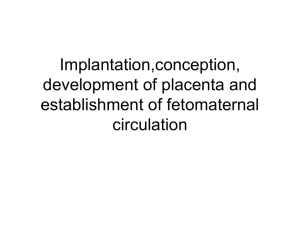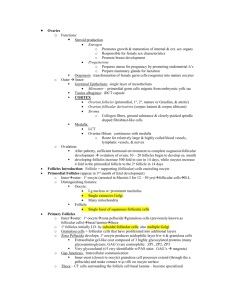2. Gamet fec segm migr
advertisement
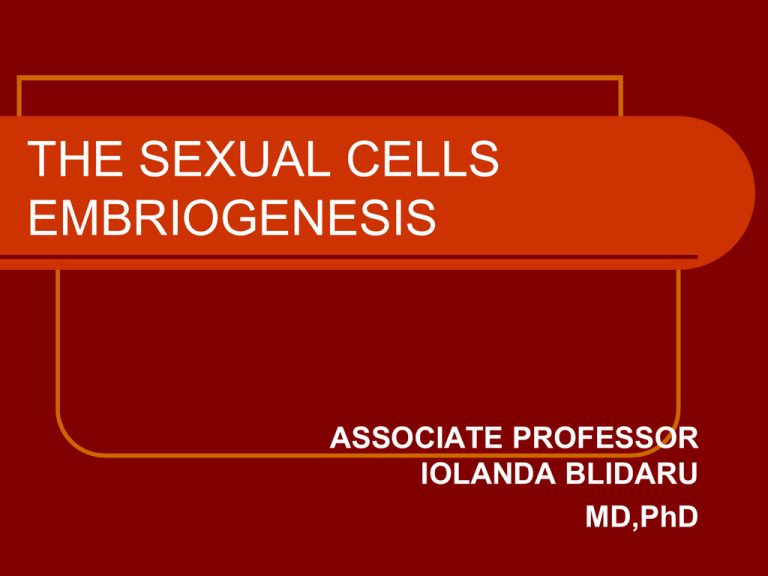
THE SEXUAL CELLS EMBRIOGENESIS ASSOCIATE PROFESSOR IOLANDA BLIDARU MD,PhD The sexual cells = gametes The spermatozoon Origin - spermatogenesis seminiferous tubule epithelium of the testis - fibromuscular wall - Sertoli cells - germ cells in different stages - vessels - Leydig cells (steroidogenesis) The spermatozoon Spermatogenesis: 74 days / continuously Spermatogonia (46XY) ▼ mitosis Spermatocyte I (46XY) ▼ meiosis Spermatocytes II (23X) + (23Y) ▼ mitosis Spermatides (23X) + (23Y) + (23X) + (23Y) ▼ metamorphosis Spermatozoa (4) The spermatozoon morphology The head The acrosome: hydrolytic enzymes (hyaluronidase, acrosine) mecanisms of fertilization The connective piece The flagellum (the tail) microtubular complex sliding motility (wave 180° rotation wave) The pre-fertilization transformations of the spermatozoa Motility Fertilization capability Capacitation – in the female genital tract increased motility loosing material from the acrosome surface exposing the receptors The acrosome reaction - a final maturation The passage of the spermatozoa in the female genital tract The vagina pH = 5 (semen - pH = 7) 5 min – 1 hour (the vagina → the tube) The cervical canal filter & reservoir (200.000 – 400.000, 24 hours) cervical mucus (tricot-like) – permisivity The utero-tubal junction filter & reservoir constant concentration (1000 → a few hundreds in the ampullary part of the tube, 2-34 hours) The ovum Ovogenesis & Folliculogenesis The embrionic-fetal life germinal epithelium (the cords) = primordial follicles The primordial follicle ovogonia 20 microns ▼ mitosis oocyte I ▼ blocked in the prophase of the first meiotic division ! granulosa cells layer basal membrane Slavjanski Ovogenesis & Folliculogenesis At puberty - 300.000 follicles in the ovaries Folliculogenesis follicle maturation - 3 months The primary follicle oocyte I (30-60 microns) granulosa cells layer zona pellucida Slavjanski membrane Ovogenesis & Folliculogenesis The secondary follicle oocyte I (45-70 microns) The tertiary follicle (Call – Exner follicle) oocyte I (60-80 microns) granulosa cell massif zona pellucida theca interna (cellular) theca externa (fibrilar) The antral follicle oocyte I (90 microns) + cumulus proliger – cAMP corona radiata Ovogenesis & Folliculogenesis The mature follicle (de Graaf) 15-20mm, unique/cycle oocyte I (100 microns), peripheral granulosa membrane Slavjianski membrane theca interna E theca externa follicular cavity - follicular fluid 15-50 years → 13 ovulations / year Folliculogenesis The follicular development 1. recruitment 2. selection 3. dominance Ovogenesis & Folliculogenesis The dominant follicle → increased 17β estradiol (8-th day) → atresia of the rest of follicles (both ovaries) → LH & FSH peak → ovulation Before the ovulation – meiosis restarts ▼ oocyte II (22x) + the first polar body Ovulation 24 h 16-40 h E2 peak LH peak ovulation The ovum can be fertilized 24 ore postovulation The effects of the LH peak the continuation of the meiosis the release of the first polar body OMI inhibition (OMI cumulus cells meiosis inhibition ←cAMP) luteinization ovum release Ovulation The process of ovum transfer from the ovary to the place of fertilization. The phenomena: complex Follicular apex → pellucida membrane rupture → stigma formation → ovulation (oocyte II + cumulus + granulosa cells + follicular fluid release) → grasped by the fimbriated extremity of the tube The granulosa and theca interna cells → luteal cells (corpus luteum) Fecundation Fertilization = a diploid egg = zygote 1. The ovum transfer from the ovary to the external ⅓ of the tube - 3 mecanisms 1. intra-tubal negative pressure 2. the contraction of the tubal fimbria 3. the contact between fimbriated tubal extremity and the cumulus 2. The spermatozoa transfer in the external ⅓ of the tube 3. The granulosa cells (cumulus oophorus) resorbtion Fecundation 4. The sperm interaction with zona pellucida and its penetration 5. Transformation of the sperm head into male pronucleus 6. Transformation of the ovum nucleus into female pronucleus (release of the 2-nd polar globe) + pronuclei attachment 7. Cromosome union ► the zygote (44+XX / XY) Fecundation Fecundation Fecundation Transformation of the head into male pronucleus. Transformation of the ovum nucleus into female pronucleus (release of the 2-nd polar globe) + pronuclei attachment Segmentation. Migration Tubal migration + segmentation (cleavage) (3-4 days) ↓ 4 blastomeres (four cell stage) ↓ 8 blastomeres (eight cell stage) ↓ unequal division (small, clear, outer mass ► trophoblast) macromeres (large, dark cells ► embryo) ↓ micromeres morula (12-16 blastomeres, fine zona pellucida) ↓ blastocist cavity fomation (ZP disappears) macromeres embryo button Segmentation Segmentation. Migration Segmentation. Migration Segmentation. Migration Segmentation. Migration Migration (tubal transport) muscle contractility epithelial cilia activity tubal fluid Implantation Post-conceptional – 7 days – up to the implantation - 3 days – the egg is in uterus The stages of implantation 1. Preimplantation 2. Attachment (apposition) – to the endometrium 3. Nidation – the blastocyst penetrates into the endometrium → decidual transformation 4. Placentation – a connection between the endometrial vessels and the trofoblastic lacunae Implantation 1. The preimplantation stage the apical membranes are not in contact the blastocyst → nurturition by “grasping” mechanism 2. The attachment stage zona pellucida dettachment in the day 6 membrane attachment day 6-7 syncronization of the blastocyst - endometrium alterations the endocrine profile of the implantation The preimplantation stage. The attachment stage The preimplantation stage. The attachment stage Nidation. Placentation. Nidation. Placentation. Implantation The 1-st week superficial blastocyst implantatation at the fundus abnormal implantation ectopic pregnancy, placenta praevia The 2-nd week Fulfilling of the implantation Enlargment of the contact with endometrium trophoblast diferentiation Endometrium decidua (caduca) Implantation Implantation The decidua consists of three layers: 1. The superficial compact layer - decidual cells 2. The spongy (deep) layer - with glands 3. The thin basal layer. The separation of placenta occurs through the spongy layer While the endometrium regenerates again from the basal layer. Implantation. Development of the egg 2-nd Week - embryonic button 2 layers = embryonic disc (endoderm + ectoderm) - amnionic cavity (between endoderm + ectoderm) - Heuser membrane delimits primitive yolk sac lecytocel - lacunae in syncytiotrophoblast) - embryotroph fluid diffusion embryonic disc maternal blood (endometrial capillaries) + eroded glands secretions Implantation. Development of the egg Day 10 – 2-nd week the egg is completely included inside the endometrium (protrudes) onset of the utero-placental circulation = opening of the uterine vessels into ST lacunae – fusion = network – intervillous space up to the end of week 2 – proliferation of CT inside ST the solid primitive villi Implantation. Development of the egg Development of the egg Week 3 gastrulation – the mezoderm appears ► trilaminar embryo embryonic disc ►a tube + umbilical cord secundary villi tertiary villi - conexion with the embryonic heart cytotrophoblastic shell – at the boundaries with the endometrium Development of the egg Development of the egg Week 4 amnionic cavity lecytocel ddivides into the umbilical vesicle + primitive gut (connected by vitelline duct) Allantois + mesenchymal tissue ► umbilical vessels anastomosys with vascular network from the villi ► feto-placental circulation Development of the egg Development of the egg Weeks 4-8 (the embryonic period) Ectoderm → nervous system, epidermis, adrenal medulla Mezoderm → skeleton, connective tissue, muscles, cardiovacular and urogenital systems Endoderm → gastrointestinal tract, liver, pancreas, gonads, dermis, respiratory system Trophoblastic invasion → extravillous trophoblast – miometrium, spiral arterioles
